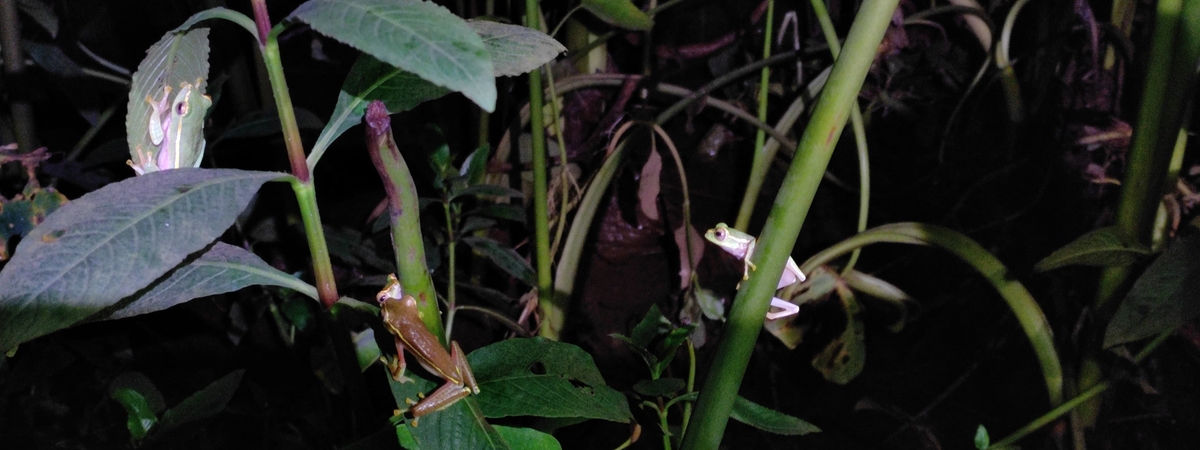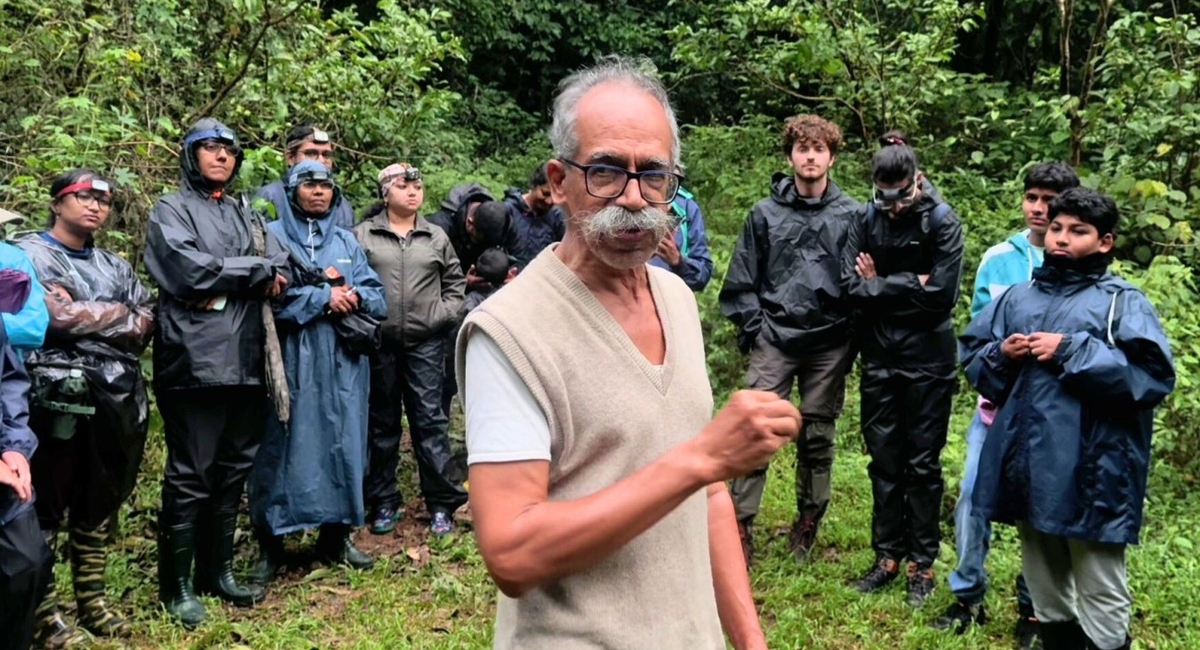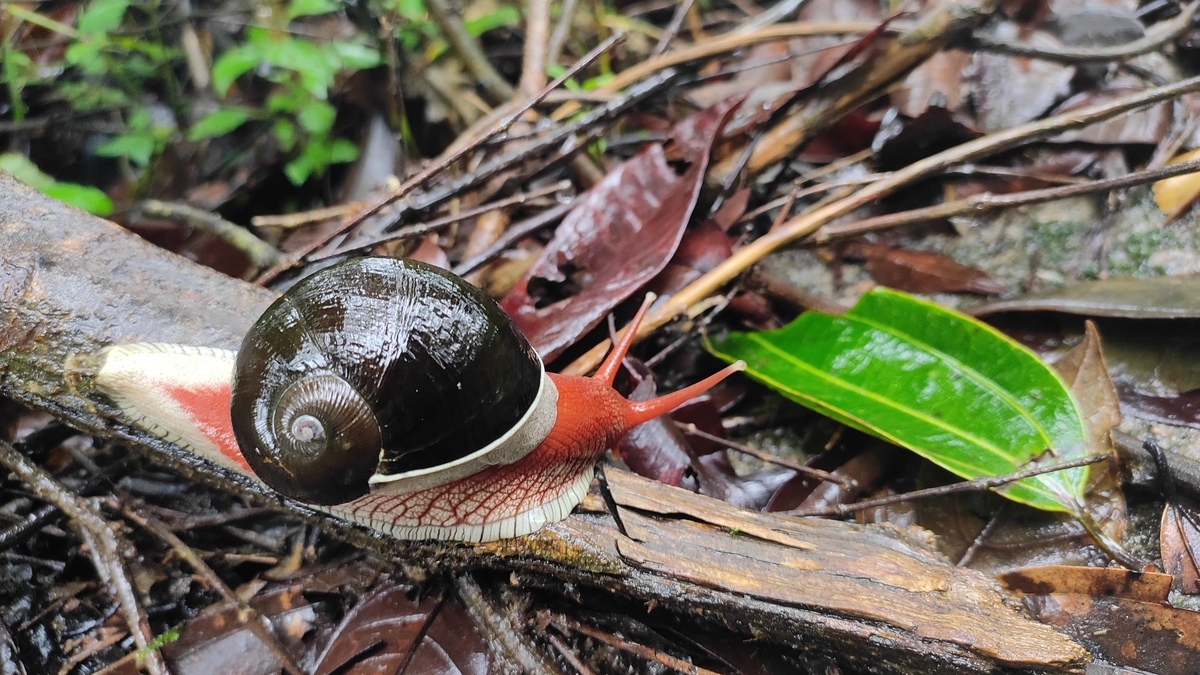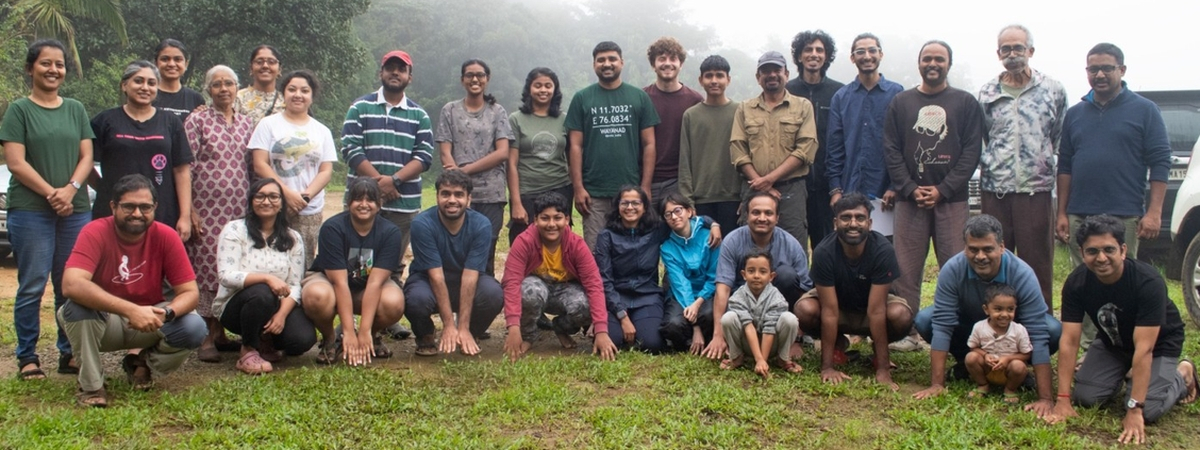Guest Post by Sona Maria Sebastian.
A Tapestry of Curiosity
Imagine being teleported to a place where emerald hills stand majestically in the foggy mist, where the air is so fresh it almost startles your lungs, and every breath tastes faintly of moss, rain, and living green. That was Bisle Ghat for me. A remote mountain pass in the Western Ghats, nestled between Kukke Subrahmanya and Sakleshpura in Karnataka, I was welcomed as a knowledge seeker into the sanctuary of frogs at Bisle Frog Watch, 13th edition, 2025, from the 11th to the 13th of July.
The transition from bustling and loud Bengaluru to the serenity of Sakleshpur was an adventure. As our Uber intercity crossed into tranquil landscapes, the cool breeze and fresh scent of the hills lulled me into peaceful slumber, lungs expanding with joy, desperate to take in all the freshness. We four strangers, sharing a ride, dove into lively discussions ranging from ecology and literature to psychology and music. I would be lying if I said we didn’t get lost on our way, but the organisers had thoughtfully given us a map and all instructions. With the internet unavailable, it felt less like a frustration and more like a liberation: losing connection with the world and finding it with my soul. I was home again.

The diversity of the crowd caught me completely by surprise: seasoned frog researchers, enthusiastic school kids in boots, curious undergraduates, an economist, a banker, a handloom owner, research scholars, a psychotherapist, a French diplomat, techies, photographers, and school teachers. Here, I learnt that curiosity knows no bounds, titles or degrees are irrelevant. All that matters is an open mind and the willingness to let new wonders in.
Frog-Lore and Fieldcraft
The workshop began with Ms. Vidhisha Kulkarni’s introduction to the world of frogs—tiny titans that demand our attention and care. One moment left us all wide-eyed: she described a frog species whose call mimics the white-throated kingfisher. We listened, enraptured, as she told the story of the Karaavali Skittering Frog and its discovery.
The afternoon unfolded into a session of playful learning: making origami frogs for a board game called ‘Hoppy Frog.’ Childlike curiosity bloomed again as all ages vied for the perfect crease, lovingly adding unique features to our colourful frogs. One was even dubbed “Pink Flog, and I saw frogs with spectacles and polka dots on them and whatnot! The board game, thoughtfully designed by Seshadri KS, Vidisha MK, and Maria Antony P, was a fun, hands-on window into the threats facing amphibians and the urgent need for conservation.
In “Finding Petu, did we succeed?” Dr. Gururaja KV introduced us to the Malabar tree toad, sharing how citizen science played a vital role in improving its conservation status from ‘vulnerable’ to ‘least concern’. In another session, Dr. Vineeth Kumar then took us deep into frog calls' symphonies, unravelling the night's secret language.

Arpita Joy transported us to her research field site through “Secrets of the Crescent Mountain,” recounting her enthralling journey with the Dattatreya night frog. Her tales wove together science, local community perspectives, and stories of the landscape, which was challenging, uplifting, and always thought-provoking. Dr. K S Sheshadri shared fascinating insights into the bamboo breeding behaviour of the Rhacophorid frogs of the Western Ghats. His story of frog fathers keeping cannibal rivals at bay in white-spotted bush frogs was amusing and mind-boggling. Discussions on ethical research practices and long-term monitoring were helmed by Dr. Sudhira H S, and Mr. Rohit shared moving photo anecdotes from his conservation journey.
Into the Amphibian Night
As dusk fell, cricket frogs sang us into the wild. Split into groups, we ventured into the unknown, spotting bush frogs, tree frogs, even the Wayanad bush frog (Pseudophilautus wynaadensis), in its slender, brownish glory. We tuned our ears to individual calls, a symphony unfolding as we found: Kudremukh bush frog (Raorchestes tuberohumerus), Rao’s intermediate golden-backed frog (Indosylvirana intermedia), Coorg yellow bush frog (Raorchestes luteolus), or I would describe as that frog that puts on a better blue eye liner due to a peculiar blue ring around its pupil. The Malabar gliding frog (Rhacophorus malabaricus) is the true acrobat among frogs. We saw a lovely couple of Malabar gliding frogs sitting on a tree branch near a pond with their foam nest on a nearby leaf. We saw the semi-terrestrial tadpoles of the Indirana genus on the moist rocky boulders with their small hind legs.
Ashokavana: Sanctuary of night frogs
Ashokavana, a private forest crafted by G N Ashokavardhana, radiated peace. His journey from running a successful book enterprise, Athree Books in Mangaluru, to guardian of the forest, saving it from resort construction, is inspiring. The innovative container home, Kappe Guddu, welcomes researchers year-round. His hospitality shone with a hot Amtekai soup, warm smiles, and an unbothered by leech bites, teaching us his reverence and what it means to be home in nature.

The Ashokavana was home to all-night frogs belonging to the Nyctibatrachus genus. We marvelled at the Kempholey night frogs, and their eggs lined on a stick. The award-winning documentary “Kappe Raaga—The Song of Kumbara” was screened in one of the workshop sessions. Viewing the film, which delves into the unique mud-packing of Nyctibatrachus kumbara, was the perfect postscript to our night excursions.
We watched the birth of a spring, clear water emerging from the forest floor, an intimate link to nature’s underground mysteries. Above us, a house centipede (Scutigera coleoptrata) prowled near frog eggs; even here, the circle of life played out in moonlit quiet.
Our night treks introduced us to a host of other beings: the slender loris with striking red eyes appeared as two bright beams on the tree, followed by a shrill Krik Call, a combination of a crackling noise and a hiss. Vine snakes camouflaged as tendrils, the vibrant Indrella ampulla slug with its soft parts painted in reddish tangerine tint, wolf spiders, slugs, variety of mushroom opened up as tiny little umbrellas and cute little buttons, millipedes wearing bumble bee costumes with black and lemon yellow bands, stick insects, checkered keelbacks weaving through puddles, and the Malabar pit viper, the celebrated star of the night treks.

Changed by the Chorus
Half of India’s frog species remain undiscovered, underscoring how much there is yet to learn and why citizen science, like backyard frog counts, is crucial. Astonishingly, even the average frog lifespan remains a mystery. The whole programme was set so that each participant sees themselves evolving within, from attaining knowledge, getting spiderman-level tingling sensations in the vicinity of frogs, tuning into individual frog calls, absorbing all the nature inside and reconnecting with nature through touch, feel, and sounds.
This workshop was a launchpad, a small step feeding into the larger conservation movement. Deep gratitude to all the resource persons, the Bisle Kappe team and Gubbi Labs for their wonderful execution that made this workshop alive. Heartfelt thanks to Belli Ganesh and his family for hosting us in his homestay and sharing the taste of local cuisines. The taste of Chitranna, chakli, and plenty of cups of coffee and tea fuelled our hearts and spirits. We left with frog cards, stickers, and keychains, a trove of little treasures.
The encouragement to observe deeply, sketch, and note before leaping to identify species set this workshop apart. This shift from hurry to presence allowed us to experience nature’s details with new eyes. It became an exercise in patience and openness, a lesson in unlearning.
The Bisle Frog Watch wasn’t just an event but an awakening. It reconnected me with nature and myself, reminding me that to be a seeker, you just need curiosity, an open mind, and the courage to listen to the many voices of the wild.


